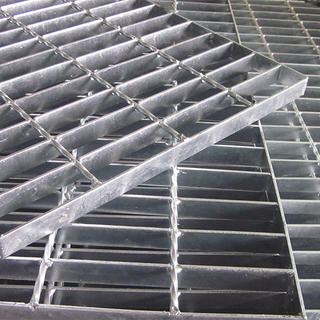Steel Grating is a robust open-grid assembly composed of load-bearing bars and cross members, welded or locked together to form a high-strength structural material. Characterized by its slip-resistant surface and excellent weight-to-strength ratio, it is widely used in industrial and architectural applications where durability and safety are paramount.
Commonly found in walkways, platforms, drainage covers, and stair treads, steel grating provides secure footing while allowing light, air, and liquids to pass through. Its design minimizes debris accumulation, making it ideal for factories, oil refineries, and wastewater treatment plants. The material's inherent strength supports heavy loads without deformation, while its open structure reduces wind resistance in outdoor installations.
Manufactured from carbon steel, stainless steel, or aluminum, steel grating can be hot-dip galvanized for enhanced corrosion resistance in harsh environments. Variations include serrated surfaces for additional traction in wet conditions and custom bar spacing for specific load requirements. Its combination of functionality, longevity, and low maintenance has established steel grating as an essential component in infrastructure, marine, and construction projects worldwide. The material's modular nature allows for easy installation and adaptability to complex architectural designs.
How thick is steel grating?
The thickness of steel grating varies depending on its intended use and load-bearing requirements. Common bearing bar thicknesses range from 3mm to 10mm (1/8" to 3/8"), with heavier-duty industrial applications using bars up to 16mm (5/8") thick. The cross bar thickness is typically thinner, usually between 3mm to 6mm (1/8" to 1/4"). Standard grating panels often have an overall thickness (including height of bearing bars and cross bars) between 20mm to 100mm (3/4" to 4"). For pedestrian walkways, thinner gratings (25-30mm) suffice, while industrial platforms or vehicle trafficked areas require thicker (50-100mm) designs. The spacing between bearing bars (19mm to 100mm) also affects structural strength—tighter spacing allows for thinner bars while maintaining load capacity. Custom thicknesses can be manufactured for specialized applications like offshore platforms or heavy machinery flooring.
What is a steel grating used for?
Steel grating is a versatile material widely used for its strength, durability, and slip-resistant properties. In industrial settings, it serves as catwalks, platforms, and stair treads in factories, oil rigs, and power plants due to its ability to support heavy loads while allowing light and airflow. Architectural applications include balconies, bridges, and decorative facades where its open design provides aesthetic appeal. Municipal projects utilize grating for drain covers, trench systems, and pedestrian bridges because of its corrosion-resistant variants (galvanized or stainless steel). In transportation, it's used for vehicle ramps, truck beds, and airport runways. Its anti-slip surface makes it ideal for marine environments like ship decks and docks. Additionally, steel grating is employed in safety barriers, shelving, and filtration systems, demonstrating its adaptability across industries.
Types of Steel Grating
Steel grating comes in several types, each suited for specific applications. Welded grating, the most common, features electrically fused cross bars and bearing bars for maximum strength in industrial flooring. Press-locked grating has interlocked bars without welding, offering a smooth surface for pedestrian areas. Riveted grating uses mechanical fasteners for high-load environments like bridges. Swage-locked grating involves swaging the cross bars into bearing bars, ideal for corrosive settings. Expanded metal grating is made from a single sheet of cut-and-stretched steel, providing cost-effective solutions for walkways. Stainless steel grating resists rust in harsh conditions, while galvanized grating offers budget-friendly corrosion protection. Serrated grating enhances slip resistance for oil platforms or food processing plants. Custom types include heavy-duty grating for extreme loads and architectural grating with decorative patterns for urban design. Each type balances strength, safety, and environmental resistance.


